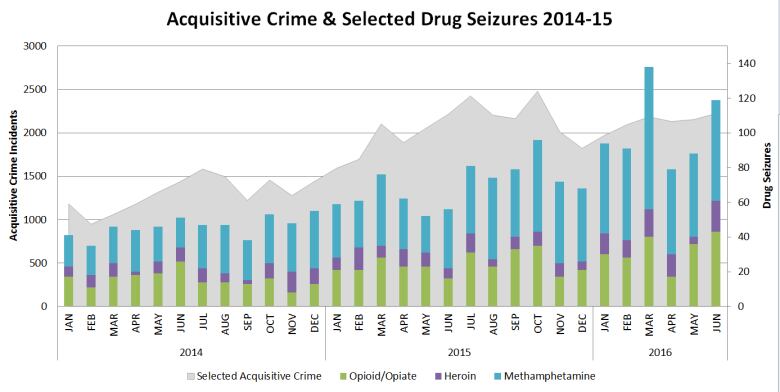Canada's crime index rises for 1st time in 12 years, lifted by spike in Alberta
StatsCan says 8 out of 13 provinces and territories reported an increase in the CSI

A "notable"uptickin police-reported crime in Alberta contributed to the first increase in the national rate in 12 years, Statistics Canada says.
The national Crime Severity Index (CSI), which measures the volume and severity of police-reported crime, jumped five per cent from 2014 to 2015, the federal agency said Wednesday.
An 18 per cent increase in Alberta, combined with smaller increases in British Columbia, Ontario and Saskatchewan, contributed to pushthe CSI up.
In all, eight out of 13 provinces and territories reported an increase in the CSI by the end of last year.
Twenty of Canada's 33 census metropolitan areas reported increased CSI rates. A29-per cent surgein Calgary was the biggest, followed by a 20 per cent increase inMoncton, a 16 per cent increase in Victoria, a 16 per cent increase in Edmonton and a 14 per cent increase inAbbotsford-Mission.
Traditional crime rates were also up in those cities, by 25 per cent in Calgary,21 per cent inMoncton and in theAbbotsfordMission area in B.C. by15 per cent.
The two citieswith the highestCSIsin2015were Saskatoon, at 112.5, and Regina, at 107.6.
While the national CSI rate rose last year, it was still 31 per cent lower than a decade ago, Statistics Canada says.
Likewise, the per-capita crime ratehas generallybeen on a downward trend since the early 1990s,with the only otherincrease reported in 2003, the data agency said.
Click on this interactive graph to explore crime severity index by province:
"Since the inception of theCSIin1998, there have only been three other occasions when a provincial increase of10 per cent or more was seen," Statistics Canada said in a release.
The traditional police-reported crime rate, which measures the volume of police-reported crime relative to population size, rose by three per cent nationally.
Non-violent crime rises 'notably' in Alberta
A gain in the national non-violent CSI was partly the result of an increase in property crime, "most notably in Alberta," the agency said.
Alberta's uptick was primarily due to an increase in incidents of breaking and entering, theft of $5,000 or under, and motor vehicle theft.
Those crimes also helped pushed up the CSI rates in New Brunswick by 13 per cent, in Saskatchewan by 10 per cent and in the Northwest Territories by 10 per cent.
Calgary police ChiefRogerChaffinsays while there is likely a correlation between the increase in property offencesand the energy downturn that has left many people out of work, a more urgent problem is the ongoing influx of highly addictivedrugs into the city and the crime that has generated.

People addicted to crystalmethandfentanylare often the ones getting arrested for non-violent offences such as vehicle theft and houseprowlings.
Chaffinsaid a simple crackdown won't be enough.
"These are not problems you can necessarily arrest your way out of," he said. "We simply have to find broader solutions."
RCMPnumbersup but not as much as province
AlbertaRCMP, which coverrural areas and communities without their own police force, said their numbers are up but not as significantly as the rest of the province.
"When comparing 2015 to 2014, RCMP-policed jurisdictions in Alberta have only seen an average five per cent increase in Violent CSI compared to the 13 per cent overall increase seen in Alberta," Insp. Gibson Glavin said in a statement.
Non-violent CSI increased an average of 12 per cent compared to a provincial increase of 22 per cent and the majority of criminal code violations were non-violent crimes in 2015, he said.
Statistics Canada says tocalculatetheCSI, each violation is assigned a weight based on its incarceration rate and the average length of prison sentence handed down by thecourts.
Weighted offences areadded up and divided by the population. TheCSIis then standardized to a numerical value of 100 based on data from the year 2006."In other words, allCSIvalues are relative to the Canada-levelCSIfor2006," the agency says.
Western provinces all reportedCSIsand crime rates in2015that were higher than the national average, with Saskatchewan continuing to record both the highestCSI, at 135.8, and crime rate, at 11,178incidents per100,000people.
Click on this interactive graph to explore crime rates (incidents per 100,000 population)by province:
Criminal Code offences up
Across the country, the rates of most Criminal Code offences were up in 2015, with 1.9 million incidents (excluding traffic) reported by police, about 70,000 more than in 2014.
Rates for some violent offences increased, including:
- Attempted murder: 22 per cent.
- Firearms offences: 22 per cent.
- Homicide: 15 per cent.
- Robbery: 5 per cent.
- Sexual assault: 4 per cent.
The rates for all types of property crimes also rose:
- Fraud: 15 per cent.
- Possession of stolen property: 13 per cent.
- Identity fraud: 9 per cent.
- Vehicle theft: 6 per cent.
- Breaking and entering: 4 per cent.













_(720p).jpg)


 OFFICIAL HD MUSIC VIDEO.jpg)
.jpg)



























































































